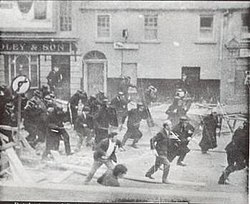
Back أعمال شغب أيرلندا الشمالية 1969 Arabic Aldarulls d'Irlanda del Nord de 1969 Catalan Ταραχές στη Βόρεια Ιρλανδία το 1969 Greek Disturbios de Irlanda del Norte de 1969 Spanish شورش ۱۹۶۹ ایرلند شمالی Persian Émeutes de 1969 en Irlande du Nord French Severoírske nepokoje v roku 1969 Slovak Kravallerna i Nordirland 1969 Swedish
| 1969 Northern Ireland riots | |
|---|---|
| Part of the Troubles | |
 | |
| Date | 12–16 August 1969 (5 days) |
| Location | |
| Methods | Demonstrations, rioting, house burnings, gun battles |
| Resulted in |
|
| Casualties and losses | |
| 8 killed 750+ injured (including 133 from gunshot wounds) | |
During 12–16 August 1969, there was an outbreak of political and sectarian violence throughout Northern Ireland, which is often seen as the beginning of the thirty-year conflict known as the Troubles. There had been sporadic violence throughout the year arising out of the Northern Ireland civil rights campaign, which demanded an end to discrimination against Catholics and Irish nationalists. Civil rights marches had been attacked by Protestant loyalists, and protesters often clashed with the Royal Ulster Constabulary (RUC), the overwhelmingly Protestant police force.
On 12 August, the Battle of the Bogside erupted in Derry: three days of fierce clashes between the RUC and thousands of Catholic/nationalist residents of Derry's Bogside district. The besieged residents built barricades and set up first aid posts and workshops for making petrol bombs. Police fired CS gas at rioters for the first time in the history of the UK. In support of the Bogsiders, on 13 August Catholics/nationalists held protests elsewhere in Northern Ireland, some of which led to violence. The bloodiest clashes were in Belfast, where seven people were killed and hundreds wounded, five of them Catholic civilians shot by police. Protesters clashed with both the police and with loyalists, who attacked Catholic districts. Scores of homes and businesses were burnt out, most of them owned by Catholics, and thousands of mostly Catholic families were driven from their homes. In some cases, police helped the loyalists and failed to protect Catholic areas. Both republican and loyalist paramilitaries were involved in the clashes.[1][2][3] There were also clashes between protesters and police in Armagh, where a protester was killed by police, as well as in Dungannon and Newry.
The British Army was deployed to restore order on 14 August, beginning the thirty-seven year Operation Banner, and peace lines were built to separate Catholic and Protestant districts. The Republic of Ireland's government set up field hospitals and refugee centres near the Irish border, and called for a United Nations peacekeeping force to be sent to Northern Ireland. The British government held an inquiry into the riots, and the reserve police force was disbanded. The riots led to a split within the IRA and the formation of the Provisional Irish Republican Army and the Official Irish Republican Army. It also led to the growth of loyalist paramilitaries such as the Ulster Volunteer Force (UVF).
© MMXXIII Rich X Search. We shall prevail. All rights reserved. Rich X Search